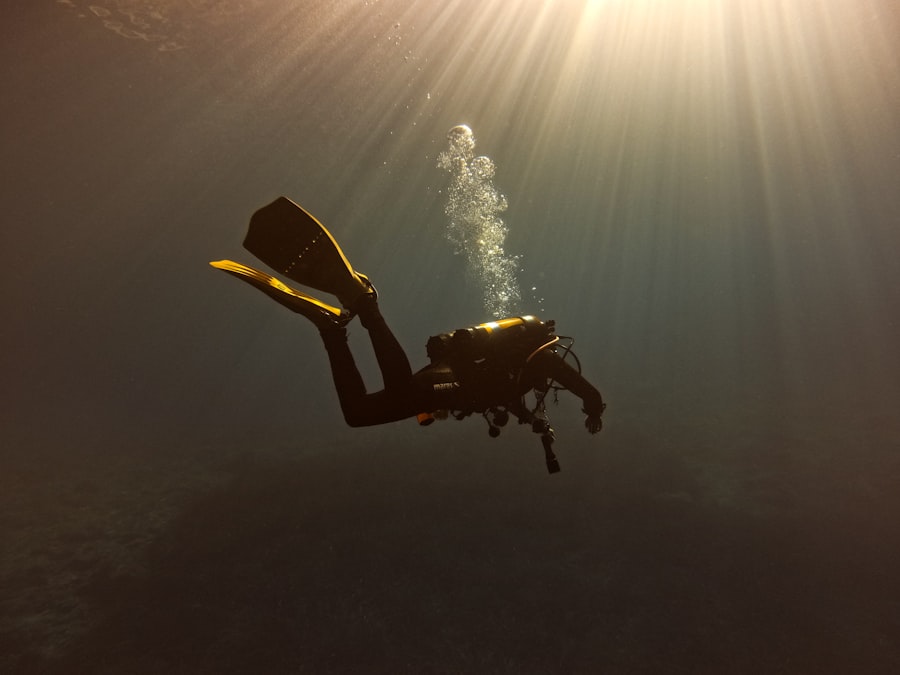Underwater drones, also known as unmanned underwater vehicles (UUVs), have emerged as a revolutionary technology in marine exploration and surveillance. These sophisticated devices are designed to operate beneath the surface of the water, performing a variety of tasks ranging from scientific research to military operations. Equipped with advanced sensors and cameras, underwater drones can gather data, monitor environmental conditions, and even conduct inspections of underwater infrastructure.
Their versatility and efficiency have made them invaluable tools in various sectors, including oil and gas, marine biology, and national security. As the capabilities of underwater drones continue to evolve, so too do the potential threats they pose. While these devices can be used for beneficial purposes, they can also be exploited for malicious activities, such as sabotage and espionage.
The dual-use nature of this technology raises significant concerns about security and safety in maritime environments. As nations and organizations increasingly rely on underwater drones for both commercial and strategic purposes, understanding their implications becomes crucial in addressing the challenges they present.
Key Takeaways
- Underwater drones are unmanned vehicles designed to operate underwater for various purposes such as exploration, research, and surveillance.
- The growing threat of pipeline sabotage poses a significant risk to critical infrastructure, national security, and the environment.
- Underwater drones are being used for sabotage by hostile actors to target and damage underwater pipelines, posing serious consequences for the economy and the environment.
- Potential consequences of pipeline sabotage include oil spills, environmental damage, economic disruption, and national security threats.
- Current efforts to combat underwater drone sabotage include the development of advanced detection and prevention technologies, as well as international cooperation and regulatory measures.
The Growing Threat of Pipeline Sabotage
Pipeline sabotage has become an alarming issue in recent years, particularly as global energy demands continue to rise.
However, their vulnerability to attacks has been highlighted by a series of high-profile incidents that have disrupted supply chains and caused significant economic losses.
The motivations behind such sabotage can vary widely, ranging from political activism to organized crime, but the consequences are often devastating. The rise of underwater drones has added a new dimension to the threat of pipeline sabotage. Traditional methods of attack, such as explosives or physical tampering, are now being supplemented by sophisticated drone technology that can operate stealthily beneath the waves.
This evolution in tactics poses a significant challenge for security forces tasked with protecting vital infrastructure. As the technology becomes more accessible and affordable, the potential for malicious actors to exploit underwater drones for sabotage increases exponentially.
How Underwater Drones are Being Used for Sabotage

Underwater drones can be employed in various ways to facilitate acts of sabotage against pipelines. One of the most concerning methods involves the use of these vehicles to plant explosives or other destructive devices directly onto pipeline structures. With their ability to navigate complex underwater environments undetected, these drones can approach critical infrastructure without raising alarms.
Once in position, they can execute their mission with precision, often leaving little trace of their presence. Moreover, underwater drones can be utilized for reconnaissance purposes prior to an attack. By gathering intelligence on pipeline locations, security measures, and operational patterns, malicious actors can plan their sabotage efforts more effectively.
This capability allows them to exploit vulnerabilities that may not be apparent through traditional surveillance methods. The combination of stealthy operation and advanced reconnaissance makes underwater drones a formidable tool for those intent on causing disruption.
Potential Consequences of Pipeline Sabotage
| Consequence | Description |
|---|---|
| Environmental Damage | Oil spills can contaminate water sources, harm wildlife, and damage ecosystems. |
| Economic Disruption | Pipeline sabotage can disrupt the flow of oil and gas, leading to supply shortages and price increases. |
| Safety Risks | Sabotage can lead to explosions, fires, and other safety hazards for nearby communities. |
| Legal Consequences | Perpetrators of pipeline sabotage can face criminal charges and legal penalties. |
The consequences of pipeline sabotage can be far-reaching and multifaceted. Economically, attacks on pipelines can lead to significant financial losses for companies involved in energy production and distribution. Disruptions in supply chains can result in increased prices for consumers and destabilize markets reliant on consistent energy supplies.
Additionally, the costs associated with repairing damaged infrastructure can be astronomical, further burdening companies and taxpayers alike. Beyond economic implications, pipeline sabotage poses serious environmental risks. Oil spills and gas leaks resulting from damaged pipelines can have devastating effects on marine ecosystems and coastal communities.
The long-term impact on biodiversity and local economies can be profound, leading to loss of livelihoods for those dependent on fishing and tourism. Furthermore, the public’s perception of safety regarding energy infrastructure can be severely compromised, leading to increased scrutiny and regulatory pressures on energy companies.
Current Efforts to Combat Underwater Drone Sabotage
In response to the growing threat of underwater drone sabotage, governments and organizations are ramping up efforts to enhance security measures around critical infrastructure. This includes investing in advanced surveillance technologies capable of detecting unauthorized underwater activity. Acoustic sensors, sonar systems, and even artificial intelligence-driven monitoring solutions are being deployed to identify potential threats before they can escalate into actual attacks.
Collaboration between public and private sectors is also becoming increasingly important in addressing this issue. Energy companies are working closely with government agencies to develop comprehensive security protocols that encompass both physical protection measures and technological solutions. Training personnel to recognize potential threats posed by underwater drones is another critical component of these efforts, ensuring that those responsible for safeguarding infrastructure are well-equipped to respond effectively.
The Role of Technology in Detecting and Preventing Sabotage

Technology plays a pivotal role in both detecting and preventing underwater drone sabotage. Advanced detection systems are being developed that utilize a combination of sonar technology and machine learning algorithms to identify unusual patterns of movement in marine environments. These systems can differentiate between benign underwater activity and potential threats posed by unauthorized drones.
In addition to detection technologies, counter-drone measures are also being explored. These may include deploying specialized drones equipped with jamming devices or nets designed to intercept unauthorized vehicles before they can reach critical infrastructure. The integration of these technologies into existing security frameworks is essential for creating a robust defense against the evolving threat landscape posed by underwater drones.
Legal and Regulatory Challenges in Addressing Underwater Drone Threats
The rise of underwater drone technology presents significant legal and regulatory challenges that must be addressed to effectively combat sabotage threats. Current laws governing maritime security may not adequately cover the unique aspects of drone operations beneath the surface of the water. This gap creates difficulties in prosecuting individuals or groups who engage in malicious activities using these devices.
Furthermore, international waters complicate matters even further, as jurisdictional issues arise when determining which nation has authority over incidents involving underwater drones. Establishing clear regulations that govern the use of drones in maritime environments is essential for creating a cohesive framework that can address potential threats while balancing the rights of legitimate users.
Case Studies of Underwater Drone Sabotage
Several case studies illustrate the potential for underwater drone sabotage and its implications for critical infrastructure. One notable incident involved an attack on an undersea pipeline that resulted in significant environmental damage due to an oil spill. Investigators later discovered that an unauthorized underwater drone had been used to plant explosives on the pipeline, highlighting the vulnerabilities inherent in existing security measures.
Another case involved a series of coordinated attacks on offshore oil rigs using underwater drones equipped with surveillance capabilities. These drones were able to gather intelligence on security protocols before launching subsequent attacks aimed at disrupting operations. Such incidents underscore the need for enhanced vigilance and proactive measures to safeguard against emerging threats posed by this technology.
The Environmental Impact of Pipeline Sabotage
The environmental consequences of pipeline sabotage cannot be overstated. When pipelines are compromised, the resulting spills can lead to catastrophic damage to marine ecosystems. Oil spills contaminate water sources, harm aquatic life, and disrupt local economies reliant on fishing and tourism.
The long-term effects on biodiversity can be profound, with some species facing extinction due to habitat destruction caused by pollution. Moreover, the cleanup process following a sabotage incident is often lengthy and costly, requiring extensive resources and expertise. The lingering effects of such environmental disasters can persist for years or even decades, impacting not only wildlife but also human communities that depend on healthy marine environments for their livelihoods.
International Cooperation in Addressing Underwater Drone Threats
Addressing the threat posed by underwater drones requires international cooperation among nations and organizations involved in maritime security. Collaborative efforts can lead to the development of standardized regulations governing drone operations in international waters while facilitating information sharing regarding emerging threats and best practices for detection and prevention. Joint training exercises involving multiple countries can also enhance preparedness against potential sabotage incidents.
By working together to develop comprehensive strategies that encompass technological advancements and legal frameworks, nations can create a unified front against the evolving challenges posed by underwater drone technology.
The Future of Underwater Drone Threats and Security Measures
As technology continues to advance at a rapid pace, the future landscape of underwater drone threats will likely evolve as well. Malicious actors may develop increasingly sophisticated methods for exploiting these devices, necessitating ongoing innovation in security measures designed to counteract such threats. The integration of artificial intelligence into detection systems may enhance their effectiveness while reducing response times during potential incidents.
Moreover, as more countries invest in underwater drone technology for legitimate purposes—such as scientific research or resource exploration—the need for robust regulatory frameworks will become even more pressing.
In conclusion, while underwater drones offer remarkable opportunities for exploration and monitoring beneath the waves, they also present significant challenges related to sabotage threats against critical infrastructure like pipelines.
As awareness grows regarding these risks, it becomes imperative for governments, industries, and international organizations to collaborate effectively in developing comprehensive strategies that address both current vulnerabilities and future challenges posed by this evolving technology.
In recent years, the use of underwater drones has become a significant factor in maritime security, particularly concerning the protection of underwater infrastructure such as pipelines. These drones are capable of conducting surveillance and inspections, making them invaluable in preventing and investigating acts of sabotage. A related article on this topic can be found on the website “In the War Room,” which delves into the strategic implications of underwater drones in modern warfare and their role in safeguarding critical infrastructure. For more insights, you can read the full article by visiting In the War Room.
WATCH THIS! The FSB’s Hidden War on Europe’s Pipelines
FAQs
What are underwater drones?
Underwater drones, also known as unmanned underwater vehicles (UUVs), are autonomous or remotely operated vehicles designed to operate underwater without a human occupant. They are used for various purposes such as oceanographic research, underwater exploration, pipeline inspection, and military applications.
What is pipeline sabotage?
Pipeline sabotage refers to the deliberate act of damaging or disrupting pipelines, which are used to transport oil, gas, or other fluids. This can be done through physical damage, such as explosives or cutting the pipeline, or through cyber attacks targeting the control systems.
How can underwater drones be used for pipeline sabotage?
Underwater drones can be used for pipeline sabotage by carrying out covert operations to damage or disrupt underwater pipelines. They can be equipped with tools or explosives to cause physical damage to the pipelines, or they can be used to gather intelligence for planning sabotage operations.
What measures are in place to prevent underwater drones from being used for pipeline sabotage?
To prevent underwater drones from being used for pipeline sabotage, various security measures are in place, including the use of underwater surveillance systems, sonar technology, and underwater security barriers to detect and deter unauthorized underwater activity. Additionally, regulations and laws are in place to control the use of underwater drones in sensitive areas such as pipeline infrastructure.
What are the potential consequences of pipeline sabotage using underwater drones?
Pipeline sabotage using underwater drones can have serious environmental, economic, and safety consequences. It can lead to oil or gas spills, environmental damage, disruption of energy supply, and potential harm to human life and property. As a result, preventing and mitigating the risk of pipeline sabotage is a priority for pipeline operators and security agencies.




